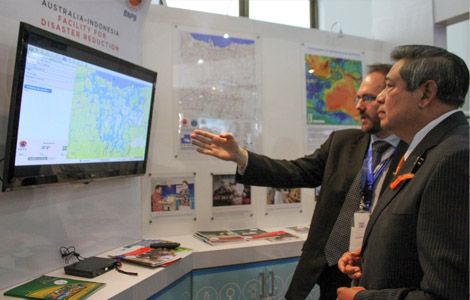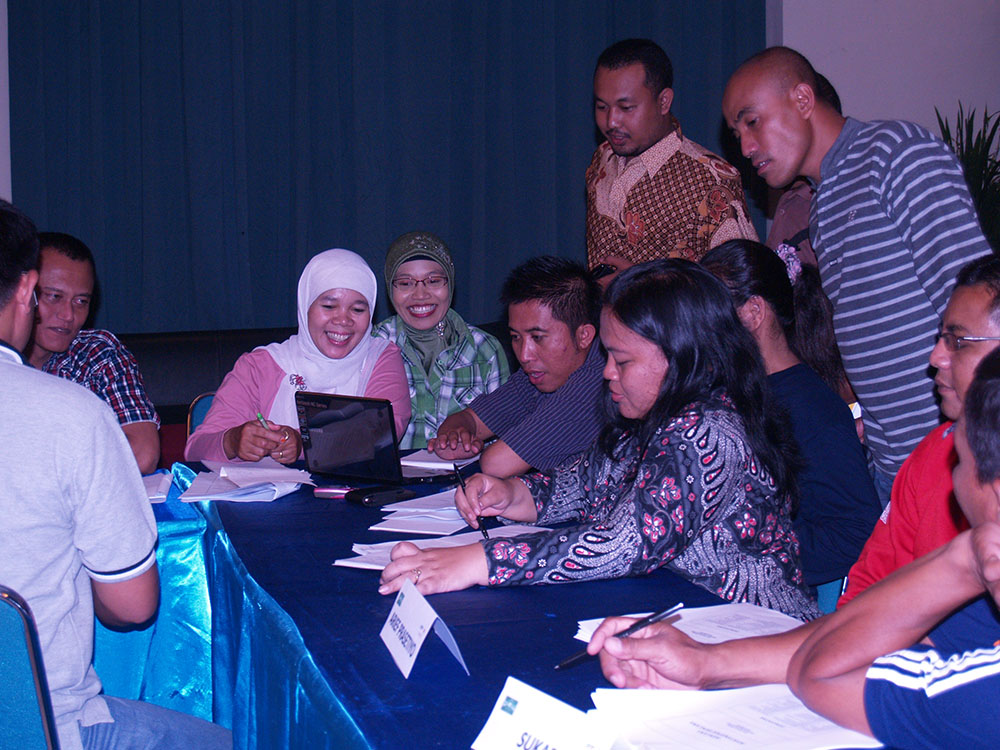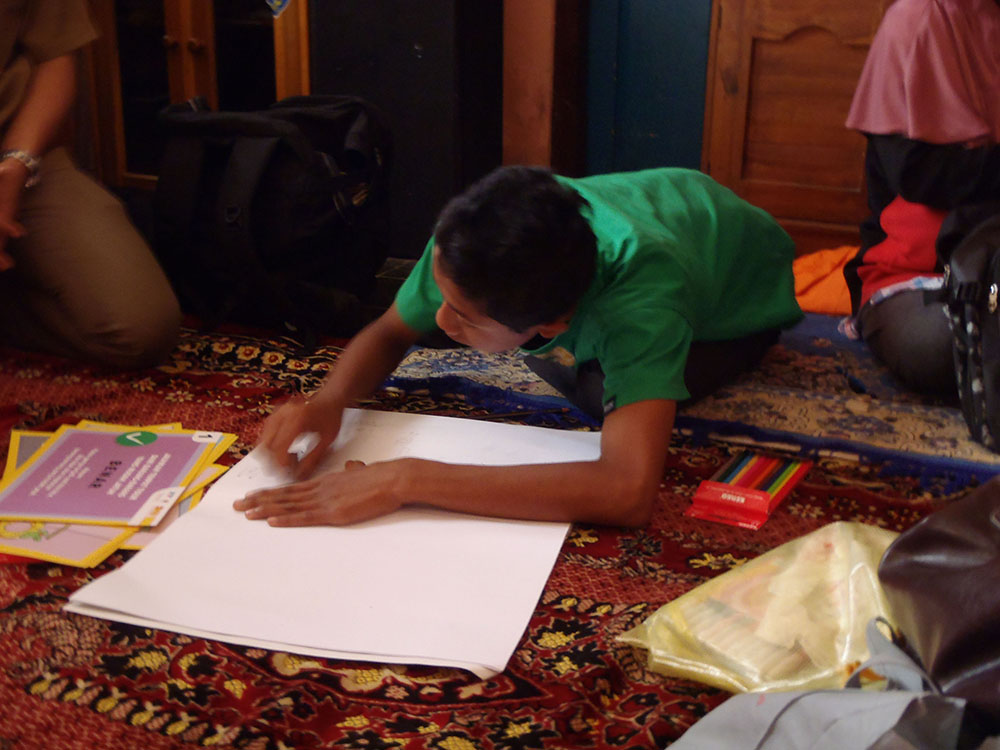Download PDF File (526 KB)
Risk and Vulnerability

To help communities better prepare for floods, earthquakes and tsunami, a new hazard impact modelling tool, the Indonesia scenario assessment for emergencies (InaSAFE) was developed by AIFDR in partnership with BNPB and the World Bank. This free and open software produces realistic disaster scenarios for contingency planning. Indonesia’s President Dr Susilo Bambang Yudhoyono praised InaSAFE as being “very beneficial for us all”.
AIFDR has also developed training material to teach Indonesian disaster managers how to use InaSAFE, OpenStreetMap and Quantum GIS to produce realistic natural hazard scenarios for contingency planning. To date, this pilot program has trained over 150 people across six Provinces in the fundamentals of using participatory mapping techniques for collecting data and the use of InaSAFE for analysing this data and informing contingency planning.
To support the Indonesian President’s Master Plan for Reducing Tsunami Risk, AIFDR brought together leading Indonesian and Australian tsunami scientists to develop Indonesia’s most robust and realistic national tsunami hazard map. This same team is now developing a realistic tsunami scenario to support BNPB’s international disaster management exercise in Padang and the Mentawai Islands.
Photo 1 – AIFDR’s Dr Trevor Dhu explaining the new hazard impact modelling tool, the Indonesia scenario assessment for emergencies (InaSAFE) to the Indonesian President, Susilo Bambang Yudhoyono
Training and Outreach

With the support of AIFDR, over 6,700 disaster managers from BNPB and BPBD’s have undertaken disaster management training across a range of areas including: rapid response; contingency planning; information; rapid assessment and coordination; community-based disaster risk management; and senior management training. This brings the total number of people trained since January 2011 to over 11,000 of which 47% were women.
To further strengthen the capacity of BNPB, AIFDR is supporting the building of two Emergency Operations Centres in Makassar and Kupang, and a new Disaster Management and Training Centre (UPT-BNPB) in Padang. The Padang Centre will function both as a training and logistics facility to support Indonesia to better prepare for disasters. When built, they will enhance disaster preparedness and response coordination across government and communities.
The Capacity Development Support Program (CDSP) also supports strengthening capacity within BNPB and selected BPBDs. There are currently 14 advisors/ consultants placed directly within BNPB and BPBD’s including in key positions to support the BNPB Deputy for Emergency Management and BNPB’s Training and Education Centre. This number will grow to 22 by the end of 2013.
Photo 2 – BNPB staff facilitate group discussion on resilient village
Partnerships

Funding to one of Indonesia’s largest Islamic organisations, Nahldatul Ulama, (2011-13) has seen a disaster management advocacy program in East Java, that includes training for local disaster management offices (BPBDs) and local communities. A key success of the program has been the ratification of local regulations (PERDA) in disaster management in eight target districts. The PERDA serves as a legal basis for the establishment of local BPBDs, administers its roles and responsibilities and allows BPBDs to gain access to budgetary funds from BNPB to conduct disaster management activities.
AIFDR is also working with the International Organization for Migration to implement a program named ‘Strengthening DRR and promoting community resilience in West Java” (2012–14). The program is being implemented in seven districts of West Java. The main activities of the program include: providing technical training in disaster management to government officials to enable them to better prepare and respond to disasters, including the establishment of a pool of disaster management facilitators through training of trainers; and facilitating workshops and providing technical support to enable the establishment of local disaster management plans in all seven districts.
Australia is a strong supporter of the ASEAN Agreement on Disaster Management and Emergency Response (AADMER), and through it, the establishment and operationalization of the ASEAN Coordinating Centre for Humanitarian Assistance on Disaster Management (AHA Centre) which is now operational. Through AIFDR, we help fund the implementation of the AADMER work program that includes support for its Emergency Rapid Assessment Team and the ASEAN Earthquake Model Project, and fund the staffing and operational costs of the AHA Centre.
Photo 3 – Community leaders and local government officers from Lumajang district of East Java province participated in NU-organized disaster management training as part of the “Advocacy on Disaster Management Institutions’ Program in East Java.
Research and Innovation

To better support people with disabilities, AIFDR funded Abeiter-Samariter-Bund to train 75 female volunteers from 15 villages to conduct home-based DRR and evacuation procedure training for 100 disabled children, their families and neighbours in Panawangan sub-district in West Java. The training was tailored to the specific needs of each child. The program also supported the establishment of disability inclusive disaster contingency plans and action plans at the family, village, sub-district and district level.
To better understand the impact of the 2010 Mt Merapi volcanic eruption on local populations, AIFDR provided research grants to three departments in UGM University in Jogjakarta. The research included: an anthropological study on the diversity of local knowledge on disaster; socio-economic recovery research; and research on the impact of volcanic ash on livestock. Research was conducted in 30 villages and temporary shelters in 4 districts in Jogjakarta and Central Java province, and is helping inform improved strategies for preparedness, response and early recovery.
A Delsos program in 11 villages in the sub-districts of Larantuka and Lembata in East Nusa Tenggara province has supported 360 female headed households by providing training on dry-land farming, DRR and land management. The project also encouraged the women to save money, and increased their access to microfinance institutions.
Photo 4 – Irfan, one of the ASB project beneficiaries with hearing impairment describes evacuation procedure through drawing.
Source: aifdr.org/index.php/key-disaster-management-successes-january-2012-february-2013
